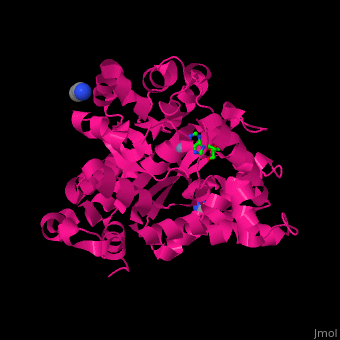Function
Adenosine deaminase (ADA) or double-stranded RNA-specific editase deaminates adenosine and deoxyadenosine into inosine or deoxyinosine. ADA is part of the purine metabolism. In humans ADA is involved in the development and maintenance of the immune system. ADA binds dipeptidyl peptidase IV. The complex acts as a positive regulator of T-cell coactivation and regulates lymphocytes-epithelial adhesion.[1]
- Double-stranded RNA-specific adenosine deaminase catalyses the C-6 deamination of adenosine in viral RNAs and cellular pre-mRNA[2].
- tRNA-specific adenosine deaminase catalyses the deamination of adenosine to inosine in tRNA[3].
Disease
ADA deficiency is the cause of severe combined immunodeficiency (SCID). SCID was the first disorder to be treated by gene therapy.
Relevance
ADA is used in testing for the presence of tuberculosis as its level is increased in TB patients.
Structural highlights
There are 2 isoforms of ADA: ADA1 and ADA2. (2pgf).[4] Water mlecules are shown as red spheres.
3D Structures of adenosine deaminase
Adenosine deaminase 3D structures

